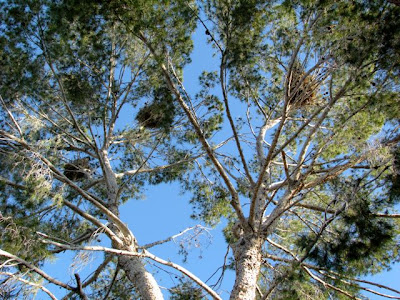Well, as Randy correctly surmised, I was in Arizona for a few weeks in February...Sun City, to be precise. Mark's mom lives there, and it was a very interesting visit, coming from snowy northern Michigan to a cactus-filled desert environment. I saw SO MANY interesting birds and critters! I had to buy a new book to try and figure out what they all were:
 |
| Lovely flicker on the cover! |
This helped a lot, but didn't cover everything. Following are some more birds that I saw in Arizona, with a few that have yet to be identified.
So this is some kind of hummingbird, but I'll be darned if I know which one. It does not seem to be either of the ones listed in
50 Common Birds of the Southwest. It was quite exciting to see it, though, and several times I was buzzed by hummingbirds while sitting on the back patio. Hummingbirds all year round in Arizona!
Here are a few that I do know, from a walk in the White Tank Mountains wilderness area:
 |
| canyon towhee |
 |
| black-throated sparrow |
 |
| gila woodpecker |
Also seen on the walk...
 |
| If this is my competition, I think I might have it beat. |
Here's one (not from the walk) that remains to be identified:
 |
| pied-billed grebe! |
 |
| ring-necked duck...just figured this one out (thank you, Sibley) |
 |
| the male ring-necked duck |
 |
| biggest mute swan ever! |
Near the lake was a tree with this little yellow bird:
Is it some kind of oriole? That's my best guess at the moment. It was pretty small, though, like titmouse-size. But then again, it was high up in a tree. It also flitted about quite a bit.
**New idea: On the way to showing Mark a picture of the starling in Sibley's Guide, I happened upon the warbler section. Now I think it must be some kind of warbler. But which one? There are a million!
***Newest idea: Audubon's yellow-rumped warbler. After looking through all the warblers in Sibley's, this seems to be the most likely.
On the way to and from the park, I would also see interesting birds. Here are a few of those:
 |
| northern mockingbird |
 |
| has to be the European starling |
 |
| an interesting fellow! |
 |
| happened to fly off just when I pressed the shutter button! |
Now here are a few nicely lined up on a lamppost that I have yet to identify:
I think they're quite lovely! If I'm not mistaken, here's another in a tree:
Is it some kind of thrasher? Kind of looks like the great-tailed grackle, though, only brown.
 |
| grackle, singing? |
Let's end back at the park, where I had quite a nice time observing a pair of mallards...yes, good old mallards...sitting under a waterfall. The male was pecking around a little bit, but the female was just sitting there under the pounding water. I thought now why on Earth would she just be sitting under that pounding water...unless she just enjoys it? She could have moved one way or the other to get out of the way, and she didn't seem to be doing anything else but sitting there. So I thought huh, it's not just about the necessities of life...it's about the pleasures of life, too, even for mallards. So we all sat there for awhile, just enjoying a nice day at the park in Arizona. :-)

































Hi Heather,
ReplyDeleteI'm very impressed that you figured out the Audubon's Warbler. That is a difficult ID - well done!
I would bet a lot of money that the hummingbird is a Costa's. Your first picture nicely shows that the wing tips reach just about to the end of the tail. I can imagine that if he would cooperate and lower his tail a little we would see that his wings in fact do reach the end of the tail. The top picture also shows a small white patch between the gorget (dark throat patch) and the dark of the back of the neck. The gorget is also elongated and the second picture shows that it flares away from the neck. Check your Sibley to see if you agree w/Costa's.
The brown grackles are just that. Remember that adult males make up less than half of any population.
I can't identify the last mystery bird. The plumage looks worn and scruffy and my first thought was winter plumage female American Goldfinch. But the bill looks too large for that. The bill looks more like a tanager but the bird looks too dark to be a female Western Tanager, which I think would be the expected tanager for Phoenix. Sorry to be no help on this one.
Randy